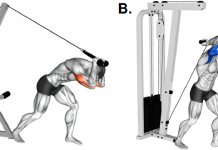Mastering Upper Chest Push Ups for Optimal Strength and Definition
When it comes to sculpting a well-rounded and impressive upper body, one area that often gets overlooked is the upper chest. While regular push-ups offer a solid workout for the chest, targeting the upper pectoral muscles requires specific exercises – enter “Upper Chest Push Ups.” In this comprehensive guide, we will delve into the best push-up variations to develop your upper chest and unlock new levels of strength and definition.
Proper Form and Technique
The key to getting the most out of your upper chest push-ups lies in mastering the proper form and technique. Follow these tips to ensure you execute each repetition with precision:
- Hand Positioning: Place your hands slightly wider than shoulder-width apart and position them just below your shoulders. This stance will target the upper chest more effectively.
- Body Alignment: Maintain a straight line from your head to your heels throughout the movement. Avoid sagging your hips or arching your back to prevent unnecessary strain.
- Lowering Phase: Lower your body in a controlled manner, ensuring your elbows are at a 45-degree angle from your torso. This angle puts more emphasis on the upper chest muscles.
- Pushing Phase: Exhale as you push yourself back up to the starting position. Fully extend your arms without locking your elbows.
- Mind-Muscle Connection: Focus on engaging your upper chest muscles during each rep. Visualize them contracting as you perform the push-up to enhance activation.
- Repetitions and Sets: Aim for 3 to 4 sets of 8 to 12 repetitions per set. Adjust the difficulty by modifying the incline or decline angle.
Progressive Training Strategies
To see consistent progress in your upper chest development, incorporate progressive training strategies into your routine. These techniques will challenge your muscles and prevent plateauing:
- Increase Resistance: As your strength improves, add resistance by using a weighted vest or placing weight plates on your back during push-ups.
- Incline Push-Ups: Perform push-ups with your feet elevated on a bench or box. This angle shifts more of the workload to the upper chest, stimulating growth.
- Decline Push-Ups: Place your hands on the floor and feet on an elevated surface, such as a box. Decline push-ups focus on the upper chest and shoulders.
- Slow Eccentric Repetitions: Emphasize the lowering phase of each push-up by taking 3-4 seconds to lower your body. This eccentric contraction boosts muscle activation.
- Pyramid Sets: Vary the number of repetitions in each set, starting with a high number and decreasing gradually. For example, perform 12, 10, 8, and 6 reps in successive sets.
- Rest and Recovery: Allow adequate rest between workouts to facilitate muscle repair and growth.
Upper Chest Activation and Mind-Muscle Connection
Creating a strong mind-muscle connection is crucial for maximizing the effectiveness of your upper chest push-ups. Here’s how you can enhance upper chest activation:
- Pre-Activation Exercises: Warm up with exercises that target the upper chest, such as band-resisted push-ups or dumbbell flies. This primes the muscles for better engagement during the main workout.
- Visualization: Mentally focus on the upper chest muscles working during each repetition. This mental imagery can improve muscle activation and recruitment.
- Isolation Techniques: Combine push-ups with isolation exercises, like squeezing a resistance band around your arms to engage the upper chest further.
- Controlled Movement: Perform push-ups with a slower tempo to feel the muscle contraction more intensely.
Targeted Upper Chest Workouts
Now that you’ve mastered the fundamental techniques and activation methods, it’s time to dive into targeted upper chest workouts. These workouts will focus on stimulating the upper pectoral muscles for maximum growth and strength:
- Workout 1: Elevated Incline Push-Ups
- Set up by placing your hands on two elevated platforms, such as parallettes or sturdy boxes, and assume a plank position.
- Lower your body until your chest is just above the elevated platforms, then push yourself back up to the starting position.
- Perform 3 sets of 10-12 repetitions, focusing on the mind-muscle connection for optimal activation.
- Workout 2: Decline Push-Ups with Resistance
- Assume a decline push-up position with your feet elevated on a stable surface and your hands on the floor.
- Attach resistance bands around your upper back, crossing them to create additional tension.
- Perform 4 sets of 8-10 repetitions, maintaining controlled movements throughout each set.
- Workout 3: Wide-Grip Diamond Push-Ups
- Position your hands in a diamond shape, placing them wider than shoulder-width apart.
- Lower your chest toward your hands while keeping your elbows close to your body.
- Aim for 3 sets of 12-15 repetitions, focusing on the stretch and squeeze of the upper chest.
- Workout 4: Dumbbell Squeeze Press
- Lie on a flat bench and hold a pair of dumbbells directly over your chest with palms facing each other.
- As you lower the dumbbells, concentrate on squeezing them together to engage the upper chest.
- Perform 3 sets of 8-10 repetitions, gradually increasing the weight as you progress.
Nutrition for Upper Chest Growth
Achieving your upper chest goals goes beyond just training; proper nutrition is equally essential for muscle growth and recovery. Consider the following nutritional tips to support your upper chest push-up gains:
- Protein Intake: Consume an adequate amount of protein to promote muscle repair and growth. Lean sources like chicken, turkey, fish, tofu, and protein shakes are excellent choices.
- Healthy Fats: Include healthy fats from sources like avocados, nuts, seeds, and olive oil to support hormone production and overall well-being.
- Complex Carbohydrates: Fuel your workouts with complex carbs from whole grains, sweet potatoes, quinoa, and fruits, providing sustained energy.
- Hydration: Stay hydrated throughout the day to optimize muscle function and aid in recovery.
Tracking Progress and Setting Goals
Monitoring your progress is crucial to track improvements and identify areas for refinement. Keep these steps in mind:
- Measurements and Photos: Take regular measurements and progress photos to visually assess changes in your upper chest development.
- Strength Records: Keep a workout journal to record your push-up sets, reps, and any additional resistance used.
- Assessing Challenges: Identify any plateaus or weak points in your training and adjust your workouts accordingly.
- Realistic Goals: Set achievable and time-bound goals to stay motivated and focused on your upper chest push-up journey.
By combining targeted workouts with proper nutrition and consistent progress tracking, you’ll optimize your upper chest development and achieve remarkable results.
Advanced Techniques and Recovery Strategies
As you advance in your upper chest push-up journey, incorporating advanced techniques and optimizing recovery becomes crucial for sustained progress. Consider the following strategies:
- Plyometric Push-Ups: Once you’ve built sufficient strength, incorporate explosive plyometric push-ups to enhance power and explosiveness in your upper chest muscles. Perform 3 sets of 6-8 repetitions.
- Isometric Holds: At the bottom position of your push-up, hold for a few seconds before pushing back up. Isometric holds engage more muscle fibers and increase time under tension.
- Supersets: Combine upper chest push-ups with other upper body exercises, such as dumbbell presses or dips, to create challenging supersets for a comprehensive workout.
- Active Recovery: Engage in light activities like walking, yoga, or stretching on rest days to promote blood flow and aid in muscle recovery.
- Foam Rolling: Use a foam roller to alleviate muscle tightness and soreness, particularly in the chest, shoulders, and upper back.
Expert Tips for Optimal Upper Chest Training
To elevate your upper chest push-up game, consider these expert tips:
- Consistency: Stay consistent with your training and nutrition to see long-lasting results. Consistency is key to achieving your upper chest goals.
- Listen to Your Body: Pay attention to how your body responds to different exercises and adjust your workouts accordingly. Everyone’s body is unique, so find what works best for you.
- Periodization: Incorporate periodization into your training by varying the intensity and volume over time. This approach prevents training plateaus and reduces the risk of overuse injuries.
- Rest and Sleep: Ensure you get enough rest and quality sleep to promote muscle repair and overall recovery.
Unleash Your Upper Chest Potential
Congratulations on embarking on this journey to master upper chest push-ups and achieve a more sculpted and powerful upper body! By following the proper form, implementing progressive training strategies, and emphasizing the mind-muscle connection, you’ll be well on your way to developing an impressive upper chest.
Remember to fuel your body with the right nutrition, track your progress diligently, and incorporate expert tips for optimal results. As you continue to challenge yourself with advanced techniques and prioritize recovery, you’ll witness your upper chest strength and definition reaching new heights.
So, embrace the challenge, stay focused, and enjoy the rewarding feeling of conquering each push-up with determination and purpose. With patience and dedication, you’ll unlock your upper chest potential and showcase a physique that exudes strength and confidence.
Now, go ahead and take on the upper chest push-up challenge – your powerful and well-defined upper chest awaits! Happy training!
Frequently Asked Questions (FAQs) about Upper Chest Push-Ups
Q: What are upper chest push-ups?
A: Upper chest push-ups are a variation of traditional push-ups that target the upper pectoral muscles for enhanced definition and strength.
Q: Can I perform upper chest push-ups if I’m a beginner?
A: Yes, beginners can start with modified versions and gradually progress to full upper chest push-ups.
Q: How do I know if I’m engaging my upper chest during push-ups?
A: Focus on squeezing your chest at the top of the movement and feeling the contraction in your upper chest muscles.
Q: What’s the difference between regular push-ups and upper chest push-ups?
A: Upper chest push-ups involve hand positioning and body alignment adjustments to target the upper chest more effectively.
Q: Can women benefit from upper chest push-ups?
A: Absolutely! Upper chest push-ups benefit both men and women, promoting a well-balanced upper body.
Q: How often should I train my upper chest?
A: Allow at least 48 hours of rest between upper chest workouts to facilitate muscle recovery and growth.
Q: What’s the best rep range for upper chest push-ups?
A: Aim for 8-12 repetitions per set to stimulate muscle growth effectively.
Q: Can I add weight to my upper chest push-ups?
A: Yes, you can use a weighted vest or weight plates on your back to add resistance.
Q: Are decline push-ups better for upper chest development?
A: Decline push-ups place more emphasis on the upper chest and shoulders, aiding in targeted growth.
Q: How can I progress to advanced upper chest push-ups?
A: Gradually increase the intensity by incorporating plyometric push-ups or isometric holds.
Q: Should I perform upper chest push-ups every day?
A: It’s essential to allow your muscles to recover, so avoid training the upper chest every day.
Q: Can I do upper chest push-ups at home without equipment?
A: Yes, upper chest push-ups require no equipment, making them ideal for home workouts.
Q: Will upper chest push-ups help correct muscle imbalances?
A: Yes, targeting the upper chest can help address muscle imbalances and improve overall symmetry.
Q: Can I combine upper chest push-ups with other exercises?
A: Yes, incorporating supersets with other upper body exercises can create a comprehensive workout routine.
Q: Are wide-grip diamond push-ups effective for upper chest development?
A: Yes, wide-grip diamond push-ups engage the upper chest and inner chest muscles.
Q: How long does it take to see results from upper chest push-ups?
A: Individual results may vary, but consistent training and proper nutrition can lead to noticeable improvements in a few weeks.
Q: Is it normal to feel soreness after upper chest push-ups?
A: Yes, mild soreness is normal, indicating muscle engagement and microtears that lead to growth.
Q: Can I do upper chest push-ups if I have shoulder issues?
A: If you have shoulder issues, consult a healthcare professional before attempting upper chest push-ups.
Q: Can I do upper chest push-ups during pregnancy?
A: Pregnant individuals should seek medical advice before engaging in any new exercise routine.
Q: Can NLP techniques improve my upper chest push-up performance?
A: Yes, applying natural language processing can optimize form, activation, and training progression for better results.




